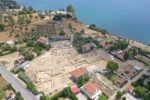 An inscription discovered at the site of the temple of Artemis on the Greek island of Euboea is the first to include the ancient name of the town: Amarynthos. This fragmentary inscription conclusively links the sanctuary of the goddess Artemis to the site mentioned by ancient sources and long sought by archaeologists.
An inscription discovered at the site of the temple of Artemis on the Greek island of Euboea is the first to include the ancient name of the town: Amarynthos. This fragmentary inscription conclusively links the sanctuary of the goddess Artemis to the site mentioned by ancient sources and long sought by archaeologists.
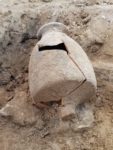 The 1st century geographer Strabo identified the temple’s location as seven stades (about a mile) from the city of Eretria. Starting in the 19th century, archaeologists used Strabo’s directions as the departure point in what would prove a fruitless century-long search for the ancient temple. In 1964, a team from the Swiss Archaeological School working with the Greek Archaeological Service began excavating in Eretria looking for the Artemis sanctuary. They were as unsuccessful as their predecessors had been, until Swiss archaeologist Denis Knoepfler found a key clue: some stones typical of ancient Greek temple construction that had been reused in a Byzantine church. They suggested the sanctuary might not have been in the city of Eretria.
The 1st century geographer Strabo identified the temple’s location as seven stades (about a mile) from the city of Eretria. Starting in the 19th century, archaeologists used Strabo’s directions as the departure point in what would prove a fruitless century-long search for the ancient temple. In 1964, a team from the Swiss Archaeological School working with the Greek Archaeological Service began excavating in Eretria looking for the Artemis sanctuary. They were as unsuccessful as their predecessors had been, until Swiss archaeologist Denis Knoepfler found a key clue: some stones typical of ancient Greek temple construction that had been reused in a Byzantine church. They suggested the sanctuary might not have been in the city of Eretria.
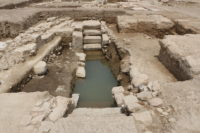 Starting in 2007, the Swiss mission moved further afield to study the surrounding territory of the city. At the foot of the Paleokeliski hill five miles east of Eretria, one mile east of the modern fishing village of Amarynthos, they unearthed a monumental portico from the 4th century B.C. In 2017, the team surveyed areas inside the portico and finally found hard evidence pointing to this having been the Artemis sanctuary. The most explicit source was an underground fountain made in the Roman era from recycled statue bases and architectural blocks. Those statue bases had surviving inscriptions, including one dedicated to Artemis, her twin brother Apollo and their mother Leto.
Starting in 2007, the Swiss mission moved further afield to study the surrounding territory of the city. At the foot of the Paleokeliski hill five miles east of Eretria, one mile east of the modern fishing village of Amarynthos, they unearthed a monumental portico from the 4th century B.C. In 2017, the team surveyed areas inside the portico and finally found hard evidence pointing to this having been the Artemis sanctuary. The most explicit source was an underground fountain made in the Roman era from recycled statue bases and architectural blocks. Those statue bases had surviving inscriptions, including one dedicated to Artemis, her twin brother Apollo and their mother Leto.
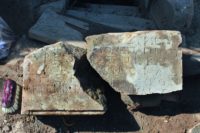 The newly unearthed inscription was also one of the statue bases reused to make the fountain. What remains of it reads “of Artemis in Amarynthos,” nailing down the identification of the temple complex as the famous sanctuary of Artemis which was one of the most important centers of worship in Greece from the 6th century through the 2nd century B.C.
The newly unearthed inscription was also one of the statue bases reused to make the fountain. What remains of it reads “of Artemis in Amarynthos,” nailing down the identification of the temple complex as the famous sanctuary of Artemis which was one of the most important centers of worship in Greece from the 6th century through the 2nd century B.C.
In 2017 inscriptions and seals with the name of Artemis were found, but the [city] name is being read for the first time this year. The fact is particularly significant because the remains of the prehistoric settlement excavated in the 70s and 80s in the same area by the Greek Archaeological Service can be identified with the Mycenaean toponym “a-ma-ru-to” mentioned in Linear B tablets found in the Mycenaean palace of Thebes. The name “Amarynthos” has been in use in the same location for over 3000 years.
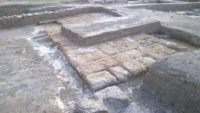 The 2019 excavation has been able to take advantage of the December 2018 demolition of a modern house that was infelicitously located above the central sanctuary of the temple. A geophysical survey revealed the foundations of monumental construction in an east-west orientation. Its state of conservation is poor making it difficult to identify, but archaeologists believe it was the main altar of the sanctuary.
The 2019 excavation has been able to take advantage of the December 2018 demolition of a modern house that was infelicitously located above the central sanctuary of the temple. A geophysical survey revealed the foundations of monumental construction in an east-west orientation. Its state of conservation is poor making it difficult to identify, but archaeologists believe it was the main altar of the sanctuary.